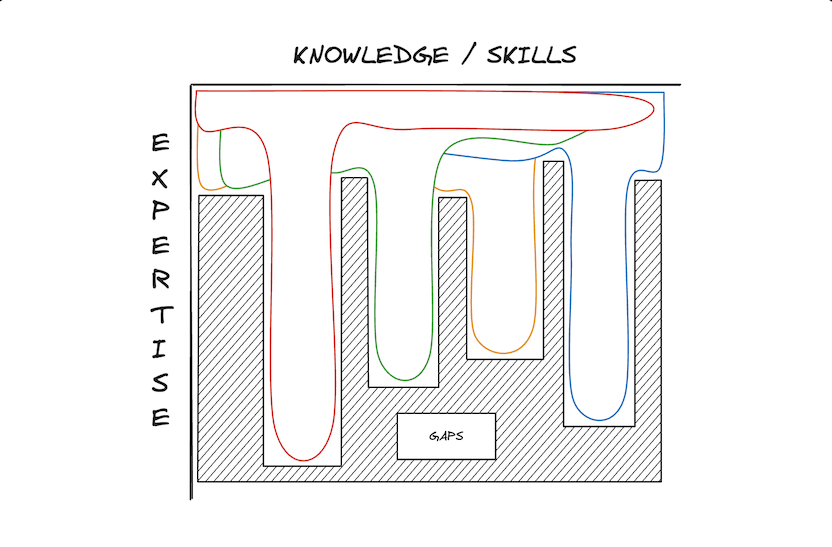The importance of T-shaped teams
Adaptability and skill diversification have become critical assets in today’s rapidly evolving business landscape. This is especially true in sectors undergoing digital transformation, where operational norms are being reshaped. Collaborating with teams of T-shaped individuals provides a significant competitive edge in this dynamic environment.
All the insights in this article stem from my professional journey. Though your perspective may vary slightly, I trust we will find common ground in most of the reflections shared here.
What are T-shaped individuals?
T-shaped individuals possess deep expertise in a specific specialization alongside broad skills across related areas. The vertical bar of the “T” signifies their profound specialization, while the horizontal bar represents their ability to collaborate and understand other disciplines. According to Tim Brown, who coined this concept, these individuals are crucial for innovation as they bring their specialized knowledge while effectively collaborating with professionals from diverse fields.

This contrasts sharply with the traditional notion of a “jack of all trades, master of none,” where breadth of knowledge often comes at the expense of depth. In T-shaped individuals, both depth and breadth are balanced, empowering a unique synergy that enhances team performance and innovation.

Benefits of T-shaped teams
- Enhanced collaboration and communication: T-shaped individuals excel in bridging communication gaps between different departments and roles. Their ability to articulate technical solutions to team members with diverse backgrounds helps ensure alignment on business impacts and project goals. This clarity and alignment streamlines decision-making processes and contributes to overall project efficiency.
- Greater independence and autonomy: T-shaped teams operate autonomously due to their diverse skill sets. As an example, having proficiency in frontend development, combined with a broad understanding of backend systems and UX/UI design principles, enables these teams to make informed decisions efficiently. This autonomy encourages a proactive approach to problem-solving and project management, empowering continuous improvement and innovation. Additionally, implementing T-shaped teams has led to improved problem-solving by leveraging diverse skill sets and perspectives to address complex challenges effectively, enhancing decision-making autonomy, and streamlining project execution with agility and alignment with customer expectations.
- Stimulation of innovation and creativity: T-shaped teams bring diverse perspectives to the table, which stimulates creativity and innovation across projects. Their ability to integrate modern frontend technologies with user-centered design principles sets benchmarks in digital experiences. This innovative mindset is pivotal for adapting to market trends and meeting customer expectations. Identifying areas for improvement proactively through training sessions and interdisciplinary projects deepens technical expertise and nurtures a culture of innovation and continuous improvement.
- Professional development and motivation: Encouraging the development of multiple skills enhances motivation and job satisfaction among team members. Initiatives that promote continuous learning and skill development deepen technical understanding and encourage a culture of personal growth. This supportive environment contributes to higher productivity, engagement, and team retention.
Key to working in T-shaped teams:
The key to working in T-shaped teams is the overlap in basic knowledge, as the generalist knowledge is practically shared by all team members. However, each team member can contribute specific expertise in various relevant fields, creating a more comprehensive knowledge network. Once the team understands the potential of each member, it can identify knowledge gaps and take actions to cover them. This creates a mesh of knowledge, allowing the team to operate more effectively and address challenges more holistically.

Challenges and solutions in developing T-shaped teams
Building and nurturing T-shaped teams pose challenges such as:
- Lack of interest in diversification: In many teams I’ve heard about, individuals prefer to focus solely on their specific roles, adopting a mindset of “I’m just doing my job”. This can hinder the development of T-shaped skills where there’s a need for a broader understanding across disciplines. Overcoming this challenge involves fostering a culture that emphasizes the benefits of interdisciplinary knowledge and encourages team members to expand their skill sets.
- Maintaining motivation: Cultivating a proactive attitude towards learning and professional growth, especially amidst constant pressures for quick delivery regardless of quality or consensus-driven decisions. This “do it, and do it now” mentality can sometimes feel like wearing “horse blinders”, narrowing focus and potentially undermining long-term motivation and innovation. Overcoming this challenge involves fostering a supportive culture that values personal development and achievement, empowering team members to balance urgency with the pursuit of excellence and continuous improvement.
The role of frontend in T-shaped teams
The frontend plays a pivotal role in T-shaped teams, serving as a central nexus in digital product development. It bridges the gap between design concepts and technical implementation, ensuring that user interfaces are not only visually appealing but also functional and intuitive. Team members specializing in frontend development collaborate closely with designers, backend engineers, and other stakeholders to translate design visions into seamless digital experiences.

As team members expand their expertise across multiple domains, they can evolve towards pi-shaped (π) or even comb-shaped profiles. A pi-shaped individual excels in two specialized areas, such as frontend and backend development, while also possessing knowledge in related fields like UI and business strategy. Meanwhile, a comb-shaped individual extends their strengths across more than two specialized areas integrating diverse skills to deliver comprehensive solutions. There are many different shaped profiles, and the examples mentioned illustrate just a few of the possibilities.
The road ahead
T-shaped teams are indispensable in navigating today’s digital business landscape. They not only enhance collaboration and operational efficiency but also drive innovation and professional growth. Investing in T-shaped teams strategically positions organizations for sustained success and leadership across diverse industries.